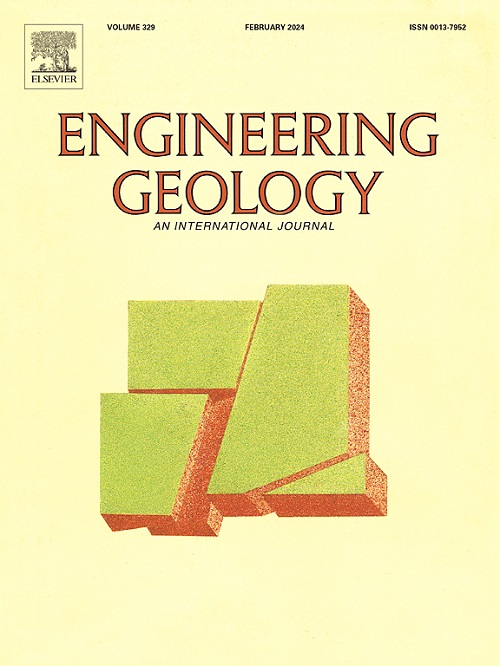Numerical estimation of river blockage and the whole lifecycle of landslide-generated impulse waves in mountain reservoirs using a hybrid DEM-SPH and SWEs method
IF 6.9
1区 工程技术
Q1 ENGINEERING, GEOLOGICAL
引用次数: 0
Abstract
Landslides occurring in mountain reservoirs could induce severe geological hazards, posing substantial risks on both the infrastructure and life. Considering the hazards always encompass different spatial and temporal scales, this paper proposes a novel hybrid Discrete Element Method (DEM) - Smoothed Particle Hydrodynamics (SPH) and Shallow Water Equations (SWEs) method to study the landslide motion and the whole lifecycle of LGIWs in a mountain reservoir. In the proposed method, the connecting between the DEM-SPH model and SWEs model is realized by transferring the hydrodynamic condition from the DEM-SPH model to SWEs model after the landslide halts, and the topography of the river channel is reconstructed based on the deposit morphology. After the validation, this method is applied to predict the hazard chains induced by ZJ landslide. The processes of landslide sliding, accumulation, impulse wave generation, propagation, running up on the dam, and dissipation are studied. The deposit morphology of the landslide and the distribution of the maximum water level are obtained. In addition, some special phenomena, such as the drainage of water from the deposit, dam-break-liked impulse waves, multiple reflections of impulse waves between the deposit and dam, and the rise of water level, are discovered under the influence of both river topography and landslide deposit. This study presents the first application of the 3D coupled DEM-SPH model in the nested near-field and far-field method, provides a useful method to comprehensively study the whole landslide-induced hazard chains in mountain reservoirs, and offers valuable references for disaster prevention and reduction.
基于DEM-SPH和SWEs混合方法的山地水库河流堵塞和滑坡冲击波全生命周期数值估计
山区水库发生滑坡,会引发严重的地质灾害,对基础设施和生命构成重大威胁。考虑到山体滑坡危害具有不同的时空尺度,本文提出了一种新的离散元法(DEM) -光滑颗粒流体力学(SPH)和浅水方程(SWEs)混合方法,用于研究山地水库滑坡体的运动和滑坡体的全生命周期。该方法通过将滑坡停止后的水动力条件从DEM-SPH模型转换为SWEs模型,实现DEM-SPH模型与SWEs模型的对接,并根据沉积物形态重构河道地形。通过验证,将该方法应用于ZJ滑坡灾害链的预测。研究了滑坡的滑动、堆积、冲击波的产生、传播、上坝和消散过程。得到了滑坡的沉积形态和最大水位的分布。此外,在河流地形和滑坡沉积的共同影响下,还发现了一些特殊现象,如沉积物的排水、类坝冲波、沉积物与大坝之间冲波的多次反射、水位上升等。本研究首次将DEM-SPH三维耦合模型应用于近场和远场嵌套方法,为全面研究山地水库滑坡全危害链提供了有益的方法,为防灾减灾提供了有价值的参考。
本文章由计算机程序翻译,如有差异,请以英文原文为准。
求助全文
约1分钟内获得全文
求助全文
来源期刊

Engineering Geology
地学-地球科学综合
CiteScore
13.70
自引率
12.20%
发文量
327
审稿时长
5.6 months
期刊介绍:
Engineering Geology, an international interdisciplinary journal, serves as a bridge between earth sciences and engineering, focusing on geological and geotechnical engineering. It welcomes studies with relevance to engineering, environmental concerns, and safety, catering to engineering geologists with backgrounds in geology or civil/mining engineering. Topics include applied geomorphology, structural geology, geophysics, geochemistry, environmental geology, hydrogeology, land use planning, natural hazards, remote sensing, soil and rock mechanics, and applied geotechnical engineering. The journal provides a platform for research at the intersection of geology and engineering disciplines.
 求助内容:
求助内容: 应助结果提醒方式:
应助结果提醒方式:


